Last updated: April 21, 2025
Article
Geologic Overview of a Bison-Carcass Site at Norris Geyser Basin
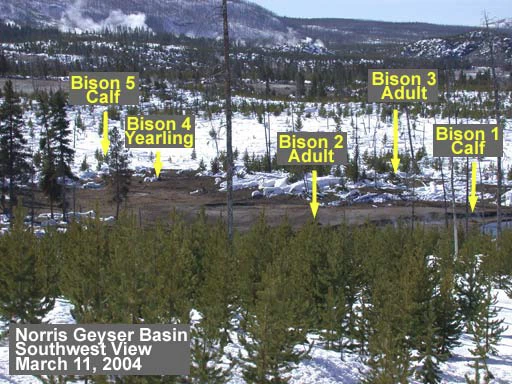
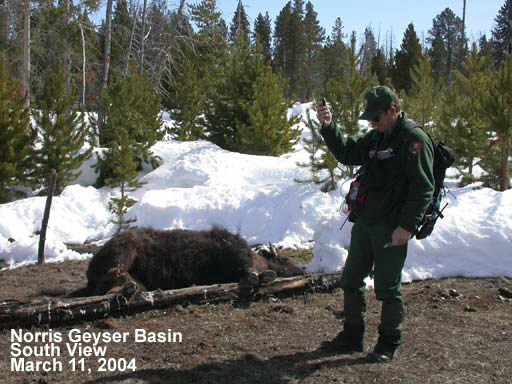
Introduction
On March 10, 2004, Bear Management personnel noticed an unusual grouping and position of bison carcasses near Norris Geyser Basin. On March 11, 2003, YNP geologists joined bear management biologists (Travis Wyman and Susan Chin) to investigate 5 bison along the Gibbon River. The adults and calves were lying on their sides with their feet perpendicular to their bodies (Figure 1). The unusual position of the carcasses led biologists to suspect that the bison had died very rapidly, as a group. Biologists established that the bison had been dead for approximately one week. Reconnaissance of the area showed that the 5 bison died along the Gibbon River and downstream of multiple gas vents. Areas with multiple gas vents are associated with thermally baked ground, minimal vegetation and sulfur deposits. Multiple gas vents occur uphill from the bison carcasses on both sides of the Gibbon River.
Data
Bison Management personnel (Doug Blanton and others) visited the site on March 10th, collecting incisors and tail hair. Members of the Bear Management team examined the 5 bison on March 11th and collected samples of blood, lung, liner and windpipe. The Bear Management team also examined body fat and bone marrow for each carcass. Body fat was present on all bison. Bone marrow was pink and solid for 4 bison. One calf had red and gelatinous bone marrow.
| Number | Animal | Age | Tissue | Teeth | Body Fat |
|---|---|---|---|---|---|
| 1 | Bison | Calf | No | Yes | Yes |
| 2 | Bison | Adult | No | Yes | Yes |
| 3 | Bison | Adult | No | Yes | Yes |
| 4 | Bison | Yearling | No | Yes | Yes |
| 5 | Bison | Calf | Yes | Yes | Yes |
Within the thermal area, an Orion Multi-Gas Detector measured concentrations of hydrogen sulfide and oxygen. Concentrations of hydrogen sulfide (H2S) varied from a high of greater than 200 ppm to 0 ppm (Figures 2 and 3, Table 2). Concentrations of greater than 200 ppm H2S were found at a vent immediately upstream from the bison carcasses (Figures 2 and 3). A second vent in the thermal area emitted steam with 177 ppm of H2S (Table 2). Within the thermal area, the air contained 56 ppm of H2S (Table 2). On the top of a small hill (Table 2), the gas meter measured 0 ppm H2S in the gentle wind. Downstream from the thermal area, the gas meter measured 1 ppm H2S (Table 2). Oxygen varied from 16 % (within a vent) to 20.8 % (within the air). On the morning of March 11th, there was a gentle breeze mixing the air.
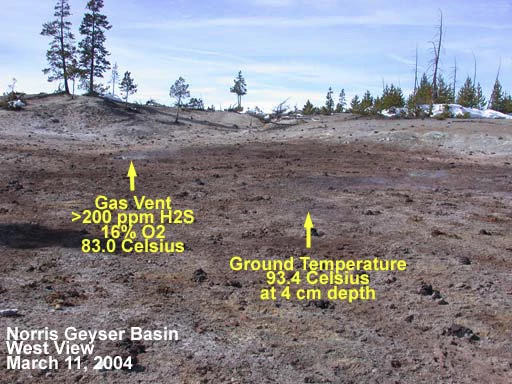
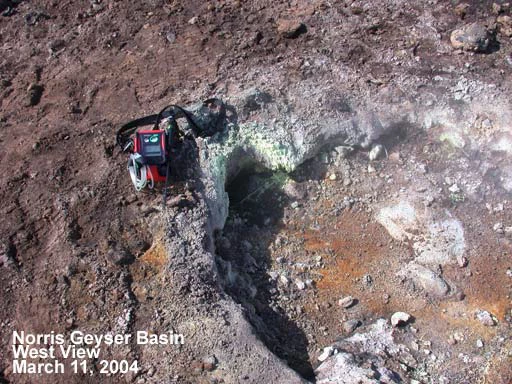
An Oakton temperature meter with a Type K thermocouple measured ground and water temperatures. Within the brown, tan, and yellow ground, temperatures varied from 27oC to 93.4oC at 4-cm depth. In places, yellow crystals of native sulfur were visible around vents. Water temperatures of a small seep (13.5oC) and thermal spring (55.9oC) were greater than the temperature of the Gibbon River (7.9oC) in the area of the bison carcasses.
| Number | Feature | H2S (ppm) |
O2 (%) |
Temperature (oC) |
|---|---|---|---|---|
| 1 | Gibbon River | Not Meas. | Not Meas. | 7.9 |
| 2 | Thermal Spring | Not Meas. | Not Meas. | 55.9 |
| 3 | Thermal Pools | 1 | Not Meas. | 13.5 |
| 4 | Mud Pot | 177 | 20.6 | 82.5 |
| 5 | Ground | Not Meas. | Not Meas. | 93.4 |
| 6 | Gas Vent | >200 | 16.0 | Not Meas. |
| 7 | Gas Vent | >200 | Not Meas. | 83.0 |
| 8 | Air | 56 | 20.8 | Not Meas. |
| 9 | Hill Top | 0 | 20.8 | Not Meas. |
Discussion
In the field, the YCR team of geologists and biologists discussed the possible effects of toxic gases such as H2S. Hydrogen sulfide (H2S) is easily recognized at concentrations of 1 ppm. The odor of H2S increases up to 30 ppm. From 1-30 ppm, humans recognize its characteristic rotten-egg smell. From 30-100 ppm, humans recognize H2S gas as “sickeningly sweet”. Above 100 ppm, a human’s ability to detect H2S is impaired. Prolonged exposures can lead to bronchitis, pneumonia, headaches, irritations of eyes, nose or throat, dizziness, nausea, shock, convulsions, coma, or death.
H2S is classed as a chemical asphyxiant, similar to carbon monoxide and cyanide gases. It inhibits cellular respiration and uptake of oxygen, causing biochemical suffocation. With a vapor density of 1.19, hydrogen sulfide is approximately 20 percent heavier than air, so this invisible gas may collect in depressions in the ground and in confined spaces.
Another toxic gas that occurs in geothermal areas is carbon dioxide (CO2). At 10%, carbon dioxide paralyzes a human’s respiratory system. The result is fatal with no evidence of an agonal struggle. The ratio of carbon dioxide to hydrogen sulfide in most geothermal areas ranges between 1,000 to 1 to 100 to 1 (Bill Evans, United States Geological Survey, Personal Communication, March, 2004).
Hydrogen sulfide and carbon dioxide can accumulate in topographically low areas on cold, calm nights because they are denser than air. For Norris Geyser Basin, no weather station exists. However, an electronic temperature logger deployed at the Norris Museum shows unusually cold temperatures on the evening of March 1st and early morning of March 2nd, 2004 (Figure 4, -17oC, (1oF) at 2:56 a.m. MST). Also, the elevation of the mapped gas vent is approximately 20 to 30 feet higher in elevation than the elevation of the bison carcasses. Therefore, it is possible that the 5 bison were asphyxiated by C02 and/or H2S gases on a cold night with still air in early March.
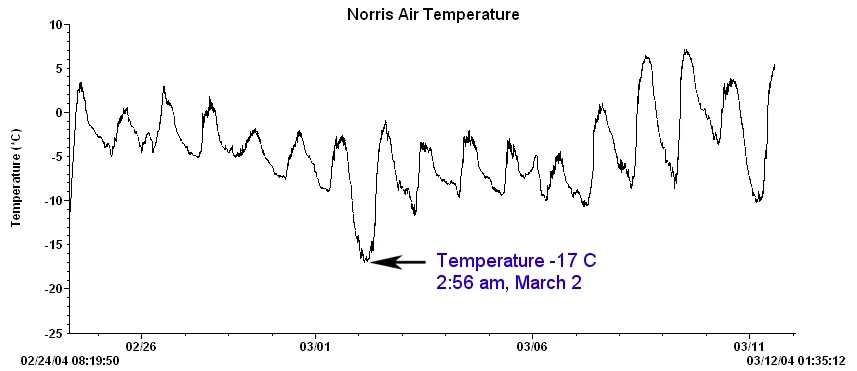
The death of animals by toxic gases is not unusual in Yellowstone National Park. Weed (1889), noted the death of 6 bears, one elk, and “several squirrels, rock hares, and other small mammals, besides numerous dead butterflies and insects” in an area now called Death Gulch in the upper Lamar River valley. Jagger (1899) also wrote of natural toxic gases in the northeast corner of Yellowstone and noted 7 dead bears in Dead Gulch in the late 1800’s. Ravines or topographically low areas can accumulate the dense, toxic gases during times of still air. A cursory survey of holdings at the Yellowstone Research Library indicates that many other people have recognized the dangers of toxic gases within Yellowstone (Ash, 1939; Frisbee, 1960, Fournier, 1959; Love and Good, 1970; Traphagen, 1904).
Conclusions
Yellowstone National Park’s active geothermal system produces toxic gases such as hydrogen sulfide (H2S) and carbon dioxide (CO2). Because few of Yellowstone’s thermal areas are in closed depressions that would concentrate these gases, the likelihood of a fatal exposure is remote. Historically, people have observed animals killed by natural, toxic emissions of gases.
Gas measurements and field reconnaissance support the idea that bison were overwhelmed by a toxic emission of gas. Hydrogen sulfide (H2S) and/or carbon dioxide (CO2) are considered the most likely gases to have catastrophically affected the 5 bison near the Gibbon River. Being more dense than air, hydrogen sulfide and /or carbon dioxide gases from vents in the nearby thermal area could have drained downhill towards the Gibbon River and overwhelmed 5 bison during late evening of March 1 or early morning, March 2, 2004.
